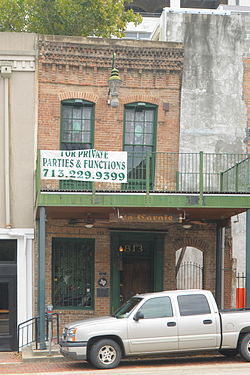
Dealey Plaza is a city park in the West End district of downtown Dallas, Texas. It is sometimes called the "birthplace of Dallas". It also was the location of the assassination of United States President John F. Kennedy, on November 22, 1963; 30 minutes after the shooting, Kennedy died at Parkland Memorial Hospital. The Dealey Plaza Historic District was named a National Historic Landmark on November 22, 1993, the 30th anniversary of the JFK assassination, to preserve Dealey Plaza, street rights-of-way, and buildings and structures by the plaza visible from the assassination site, that have been identified as witness locations or as possible locations for assassin(s).

The Texas School Book Depository, now known as the Dallas County Administration Building, is a seven-floor building facing Dealey Plaza in Dallas, Texas. The building was Lee Harvey Oswald's vantage point in his assassination of United States President John F. Kennedy on November 22, 1963. Oswald, an employee at the depository, shot and killed President Kennedy from a sixth floor window on the building's southeastern corner; 30 minutes after the shooting, Kennedy died at Parkland Memorial Hospital. The structure is a Recorded Texas Historic Landmark, located at 411 Elm Street on the northwest corner of Elm and North Houston Streets, at the western end of downtown Dallas.

The Old Market is a neighborhood located in downtown Omaha, Nebraska, United States, and is bordered by South 10th Street to the east, 13th Street to the west, Farnam Street to the north and Jackson Street to the South. The neighborhood has many restaurants, art galleries and upscale shopping. The area retains its brick paved streets from the turn of the century, horse-drawn carriages, and covered sidewalks in some areas. It is not uncommon to see a variety of street performers, artists, and other vendors.

The Lundberg Bakery is a historic building in downtown Austin, Texas. It is located at 1006 Congress Avenue, half a block south of the Texas State Capitol grounds. It was added to the National Register of Historic Places on December 17, 1969.

The Wilson Building is an historic 8-story building in the Main Street district of downtown Dallas, Texas. The building was completed in 1904 and patterned after the Palais Garnier in Paris, France. The historic structure fronts Main Street on the south, Ervay Street on the east, and Elm Street on the north. The Wilson building was the tallest structure in Dallas from 1904–1909 and was considered the premier commercial structure west of the Mississippi. The Wilson Building is situated across from the flagship Neiman Marcus Building and is adjacent to the Mercantile National Bank Building.
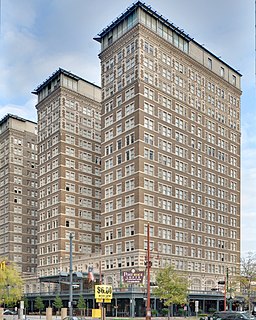
The Rice, formerly the Rice Hotel, is an historic building at 909 Texas Avenue in Downtown Houston, Texas, United States. The current building is the third to occupy the site. It was completed in 1913 on the site of the former Capitol building of the Republic of Texas, and is listed on the National Register of Historic Places. The old Capitol building was operated as a hotel until it was torn down and replaced by a new hotel around 1881. Jesse H. Jones built a new seventeen-story, double-winged hotel in 1913, also called "The Rice Hotel." This building underwent major expansions: adding a third wing in 1925, adding an eighteenth floor in 1951, and adding a five-story "motor lobby in 1958. In addition, there were several renovations during its life as a hotel. It continued to operate as a hotel before finally shutting down in 1977. After standing vacant for twenty-one years, The Rice was renovated as apartments and reopened in 1998 as the Post Rice Lofts. It was sold in 2014 and renamed simply The Rice.
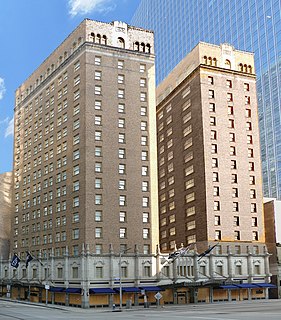
The Club Quarters Hotel is a 16-story, 61.6 m (202 ft) Beaux-Arts high-rise at 710 Fannin Street in downtown Houston, Texas, USA. The building is listed on the National Register of Historic Places as the Texas State Hotel.
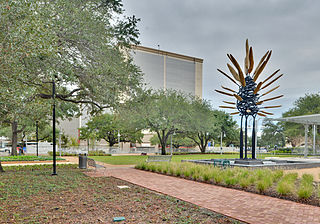
Main Street Market Square Historic District is a historic district in Houston that includes the Market Square Park. It includes buildings nearby, as well as the square itself. It was listed on the National Register of Historic Places in 1983.

Ashton Villa is a fully restored, historic home located on the corner of 24th and Broadway in Galveston, Texas, United States. Constructed in 1859, it was one of the first brick structures in Texas.

The former Riede's City Bakery building is located on East Hyman Street in Aspen, Colorado, United States. It is a small wooden commercial building erected in the 1880s. In 1987, it was listed on the National Register of Historic Places.

The Burge House is a historic house located in Houston, Texas, United States. It was listed on the National Register of Historic Places on June 22, 1983. It is in the Houston Heights neighborhood, one of the first planned suburbs in Texas.

Fayetteville Historic District is located in Fayetteville, Texas. The small town of Fayetteville is in rural south east central Texas midway between Houston and Austin. The oldest extant building in the district was constructed in 1853. The historic district represents most of the development within town boundaries as indicated by street signs, the boundaries have been drawn to exclude some areas in town occupied primarily by construction from after 1958. The area of the district is 153.5 acres (62.1 ha) and includes 345 properties considered historical and largely intact. An additional 137 properties within district boundaries are not considered for contribution to the historic status of the district. It was added to the National Register of Historic Places (NRHP) on July 10, 2008.

The Texas Company Building, located at 1111 Rusk in Houston, Texas, was listed on the National Register of Historic Places on April 2, 2003.

The Oriental Textile Mill, located at 2201 Lawrence Street in the Houston Heights neighborhood of Houston, Texas, was listed on the National Register of Historic Places on June 22, 1983.
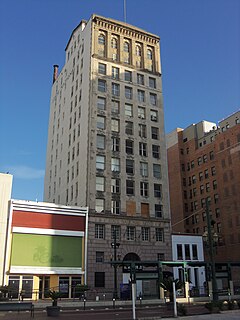
The State National Bank Building is a high-rise office building located at 412 Main Street in downtown Houston, Texas. Designed by architect Alfred Charles Finn, the building was built in 1923 in the Spanish colonial style. It was listed on the National Register of Historic Places on August 11, 1982.

The City National Bank Building, located at 1001 McKinney Avenue in Houston, Texas, was listed on the National Register of Historic Places on April 3, 2000.

Moquin's Bakery, also known locally as the Biscuit Factory and the National Biscuit Company, is a historic former industrial facility at 78 Rose Street in Burlington, Vermont. Built in 1915 by a local bakery, it was acquired and enlarged by the National Biscuit Company, which operated here until 1969. The building was listed on the National Register of Historic Places in 1997 for its economic and commercial historic significance, and has since then been converted into residences.

The Holly Hotel, also known as the Hirst Hotel, is an inn located at 110 Battle Alley in Holly, Michigan. It was listed on the National Register of Historic Places in 1980. It currently operates as a restaurant.

The Thomas Earl House was built as a single-family home located at 415 North Main Street in Ann Arbor, Michigan. It was listed on the National Register of Historic Places in 1992. The house has been renovated to office space.

The Stowers Building is located at 820 Fannin Street in downtown Houston. The building was constructed in 1913 and is listed on the National Register of Historic Places (NRHP). The building is named for George Arthur Stowers and his furniture company, which had moved into the new "skyscraper" after a fire at his Main Street store. The local firm of Green & Finger designed the ten-story building which was constructed out of reinforced steel by Pearson & Co. The building was representative of a period of skyscraper construction in Houston between 1908 and 1913. It is listed on the National Register of Historic Places.
